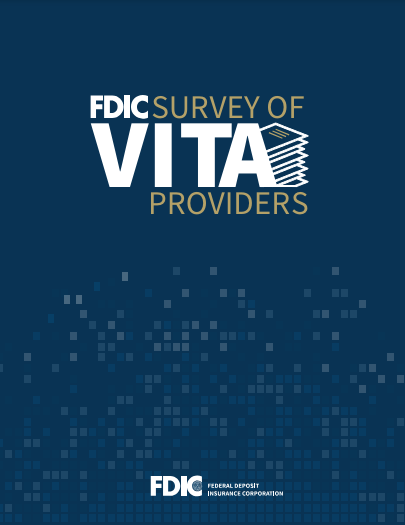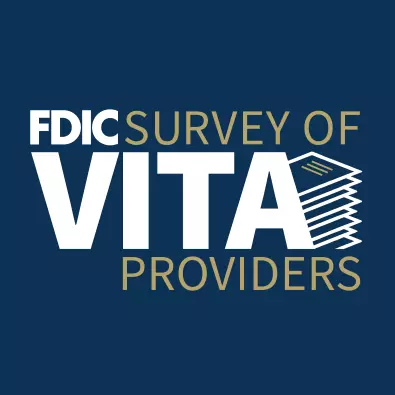About the Survey
The purpose of the FDIC Survey of Volunteer Income Tax Assistance (VITA) Providers is to better understand potential opportunities to help unbanked clients of VITA sites open bank or credit union accounts to direct deposit their tax refunds and credits. The survey was fielded from May 15 to June 23, 2023. Of the 486 VITA sites that were invited to participate, 351 responded (72 percent response rate), of which 99 had a partnership with a bank or credit union in the 2023 tax season. The survey response benefited greatly from collaboration between the FDIC and the Stakeholder Partnerships, Education and Communication Office of the Internal Revenue Service.
Main Takeaways
- Of respondent sites already partnered with a bank or credit union (partnered sites), 94 percent planned to either increase or continue efforts to provide banking services in the 2024 tax-filing season
- Of sites not currently partnered with a bank or credit union (nonpartnered sites), 55 percent identified barriers other than demand as reasons for not partnering
- Of all respondent sites, 70 percent already engaged in activities related to financial well-being, such as encouraging clients to save tax refunds or offering financial-counseling services
- A third of respondent sites without banking partnerships (33 percent) reported at least one knowledge barrier, such as lack of awareness of the possibility for partnership or how to execute a partnership
- Another third (34 percent) reported at least one comfort barrier, including discomfort in providing banking assistance in a staff or volunteer role and concern about client privacy
- Forty-two percent indicated at least one resource barrier, including not having enough funding or in-kind support for banking services and lack of availability of a banking partner
- Almost a third (31 percent) of respondent sites with banking partners met their partner through an event or network, and a quarter (25 percent) formed their partnership as a result of the initiative of the partner
- The practices most frequently reported as “very useful” for opening bank accounts to increase direct deposit were: opening accounts with banking partners on-site, “warm handoff” off-site referrals to partners, and providing links to trusted websites for clients to open accounts on their own
- Only 41 percent of partnered respondent sites could confirm that accounts partner institutions offered to their clients met Bank On National Account Standards
- Among partnered respondent sites, 65 percent were willing to provide clients lists of local institutions that offered Bank On accounts, 58 percent were willing to provide a website link to find local institutions that offered these accounts, and 40 percent were willing to partner with institutions that met Bank On standards (another 41 percent were already partnered with Bank On certified institutions)
- Among nonpartnered respondent sites, 66 percent were willing to provide clients lists of local institutions that offered Bank On accounts, 61 percent were willing to provide a website link to find local institutions that offered these accounts, and 51 percent were willing to partner with institutions that met Bank On standards
Implications
- Networking events can promote partnerships between banks and VITA organizations.
- Banks can be informed of the role of VITA sites and consider the benefits of initiating partnerships.
- VITA sites can confirm that current or potential partner institutions provide safe and affordable accounts, such as accounts that meet Bank On National Account Standards.
- materials that share practices partnered sites consider useful and that explain what banking partnerships are and how to form and implement them;
- materials that address common concerns, such as whether volunteers and staff providing banking services is appropriate and the potential implications for client privacy; and
- tools that allow VITA sites to easily identify local branches of institutions that offer Bank On accounts.
- implementing more personal referral methods when adopting off-site account-opening practices, including the use of warm handoffs;
- providing account-opening assistance on-site when clients are already present for tax-preparation services; and
- communicating at other steps of the tax-preparation process that account-opening assistance is available, including when sites deliver services virtually.
Table of Contents
1. A Survey of VITA Sites to Explore Opportunities for Economic Inclusion
2. Survey Questions in the Context of VITA Operations
3. Demand for Banking Services Exists at VITA Sites
4. Knowledge, Comfort, and Resource Barriers Prevent Nonpartnered Sites From Forming Partnerships
6. VITA Sites Are Willing to Connect Clients to Safe Accounts


